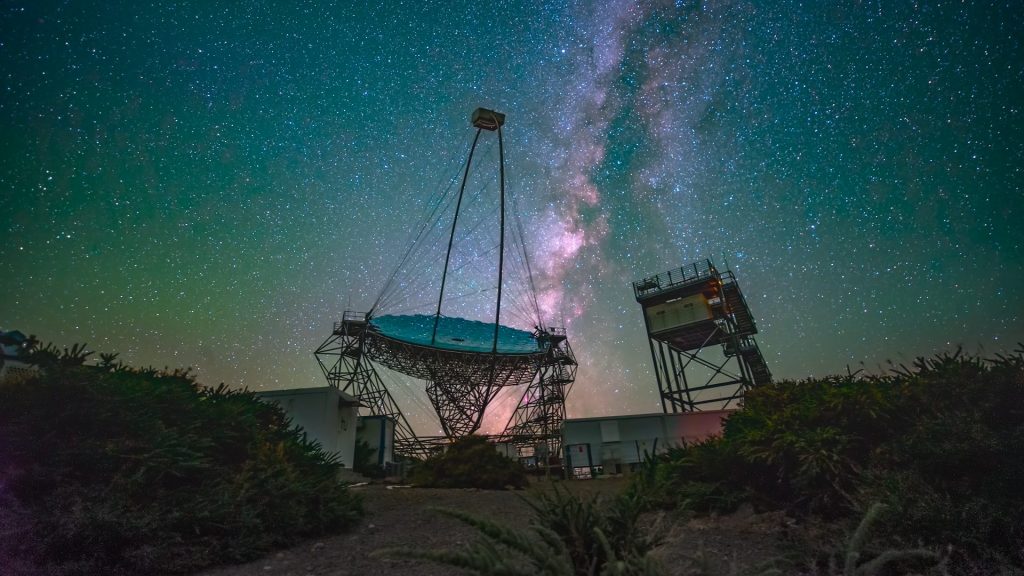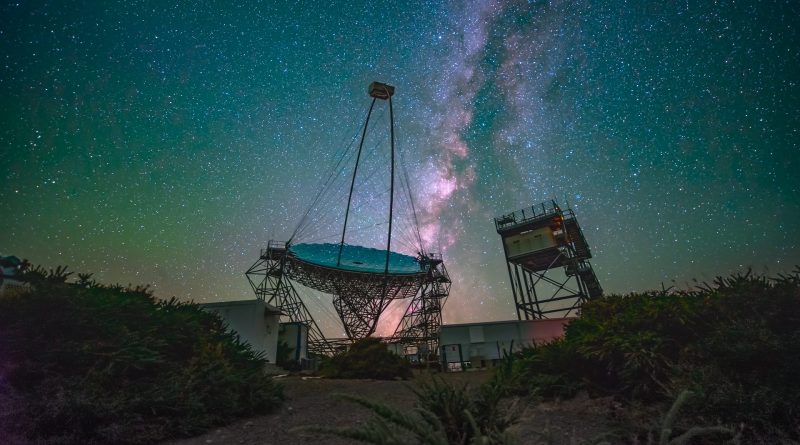LST-1 Discovers the Most Distant AGN at Very High Energies
On 15 December, the Large-Sized Telescope (LST) Collaboration announced through an Astronomer’s Telegram (ATel) the detection of the source OP 313 at very high energies with the LST-1. Although OP 313 was known at lower energies, it had never been detected above 100 GeV, making this the LST-1’s first scientific discovery. With these results, OP 313 becomes the most distant Active Galactic Nuclei (AGN) ever detected by a Cherenkov telescope, further showcasing the LST prototype’s exceptional performance while it is being commissioned on the CTAO-North site on the island of La Palma, Spain.
OP 313 is what is known as a Flat Spectrum Radio Quasar or FSRQ, a type of AGN. These are very luminous objects found in the centres of some galaxies, where a supermassive black hole devours material from its surroundings, creating powerful accretion disks and jets of light and relativistic particles.
The LST-1 observed this source between December 10 and 14. These observations are the result of daily monitoring of data from the Fermi-LAT satellite by LAPP teams. The tools put in place by the LAPP group have made it possible to detect unusually high activity in the high-energy gamma-ray range, which has also been confirmed in the optical range by various instruments. With just four days of data, the LST Collaboration was able to detect the source above 100 Gigaelectronvolts (GeV), an energy level a billion times higher than the visible light humans can perceive.
Only nine quasars are known at very high energies, and OP 313 is now the tenth, and especially the first detection by LST-1. In general, quasars are more difficult to detect at very high energies than other types of AGN. This is not only because the brightness of their accretion disk weakens the emission of gamma rays, but because they are further away. In this case, OP 313 is located at a redshift of 0.997 or 8 billion light years away, making it the most distant AGN and the second most distant source ever detected at very high energies.
The more distant the source, the more difficult it is to observe at very high energies due to the so-called Extragalactic Background Light or EBL. The EBL is the collective light emitted by all objects outside the Milky Way that expands across multiple wavelengths, from visible, infrared and ultraviolet. The EBL interacts with very high-energy gamma rays, attenuating their flux and, thus, making their observation challenging. The characteristics of the LST-1, with an optimized sensitivity for the CTAO’s low energy range, between 20 and 150 GeV, where gamma rays are less affected by the EBL, enabled the LST Collaboration to extend the study of this source to tens of GeV for the first time.
The LST Collaboration will analyse the data taken with LST-1 and extend the analysis to different wavelengths to obtain a more precise analysis that allows scientists to improve their understanding of the EBL, study the magnetic fields within this type of source or delve into fundamental intergalactic physics.
The LAPP group, which was heavily involved in this discovery, will continue its work on the various alerts and new possibilities for detecting even more interesting objects.
The LST-1 is a prototype of the Large-Sized Telescope for the CTA Observatory, located on the island of La Palma in Spain. The design of the telescope is optimised for observing gamma rays in the range 20 GeV to 3 TeV. LAPP is involved in the construction, commissioning and operation of this telescope, as well as the CTA observatory.
Pour plus d’informations :
- CTAO Press Release: https://www.cta-observatory.org/lst1-makes-first-scientific-discovery-by-detecting-the-most-distance-agn/
- Atel: https://www.astronomerstelegram.org/?read=16381
- Contact atLAPP : David Sanchez



